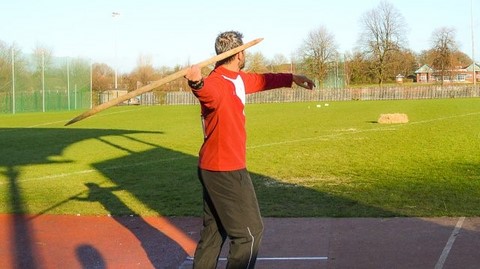300,000 y old ballistics technology: the Neanderthal spears of Schoeningen

Writes Jörg Römer, journalist of Der Spiegel:
On a Thursday this month I found myself standing in front of the Gropius Building in Berlin, waiting in line for nearly an hour under a driving snow, together with others like me who were eager to see to highly vaunted exhibition: «Eventful times. Archaeology in Germany. »
Crowds clustered around the Nebra sky disk and the Golden hat of Berlin. In the «war » section, visitors jostled around sophisticated Roman ordnance and ornate swords. Yet there was one exhibit which many passed by, paying scant attention to. It was a spear from the archaeological find of Schöningen, in Lower-Saxony. Its age is estimated at at least 300,000 years. The hunting weapons coming from this arsenal are considered to be the oldest in existence. Yet, it would be easy to overlook them, taking them for simple hiking sticks.
Once upon a time, equiped with similar weapons, the Neanderthals and their ancestors Homo Heidelbergensis roamed stone-age Europe. What can be achieved with the help of those thin sticks has just been demonstrated by British scientists: for the sake of experiment, they recruited practiced javelin throwers. The athletes were to pretend to be hunting Neanderthals and show how acurately the prehistoric weapons could be thrown. And how much kinetic energy they could develop.
As it happens, the javelin throwers were able to project letal force with precision at a distance of 20 meters and more, according to the researchers' report in the scientific magazine « Nature. » This may not seem like much. But it casts a whole new light on the whole area of early weapons technique. Until now, scientists had satisfied themselves with the fact that these pine-sticks could achieve a respectable throwing distance, but thought that they could inflict letal injury to animal quarry only if used close-up, as thrusting weapons. Not true. For the craftsmen of 300,000 years ago had already figured out that the center of gravity of the spear had to be situated in the front third of the weapon, just as is the case today in modern competition javelins. The carefully worked wooden sticks contain far more technology than had been surmised hitherto.
Jörg Römer, January 26, 2019.
Translated from the German by Anne-Marie de Grazia
Go to the original article in Der Spiegel
We have been paying quite a bit of attention to the Neanderthals in Q-MAG.org. This latest discovery is indeed worthy of attention.
Go to the article in Nature - Scientific Reports: External ballistics of Pleistocene hand-held spears: experimental performance data and implications for human evolution.
Read also:
The "Neanderthals in Naxos" exhibition
Neanderthal jewels and fashion
Neanderthal - the painter and installation artist
Dentistry in the Upper-Palaeolithic
Hohle-Fels: 40,000 years of rope-making
Neanderthals used chemical fire-starters
A hardware store for the Neanderthals
Neanderthals transmitted a taste for nicotine and a predisposition for depression
Alfred de Grazia's seafaring Neanderthals of Stelida (Naxos)


